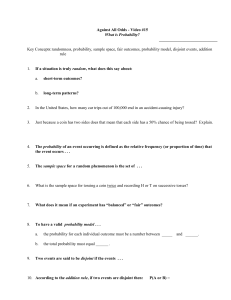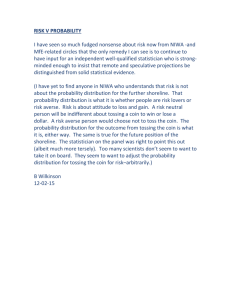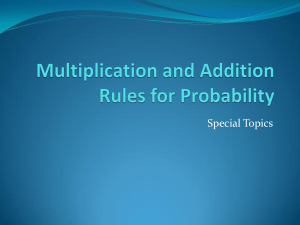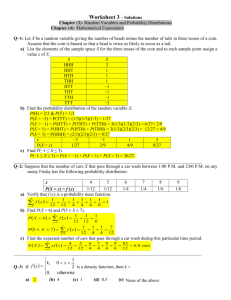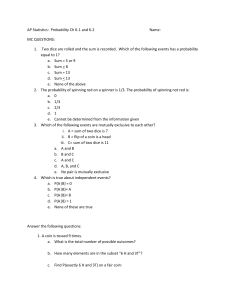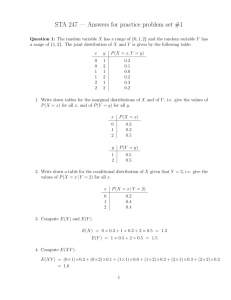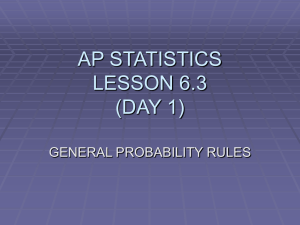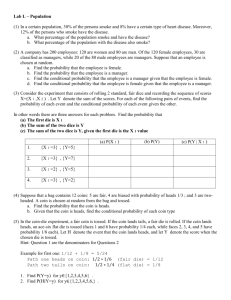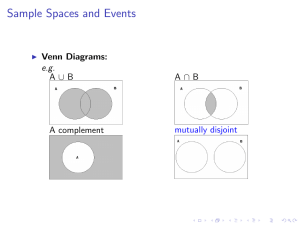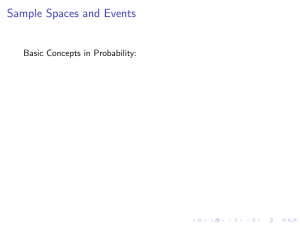Statistics 111 - Lecture 1 Intro to Probability Deterministic vs. Random Processes
advertisement
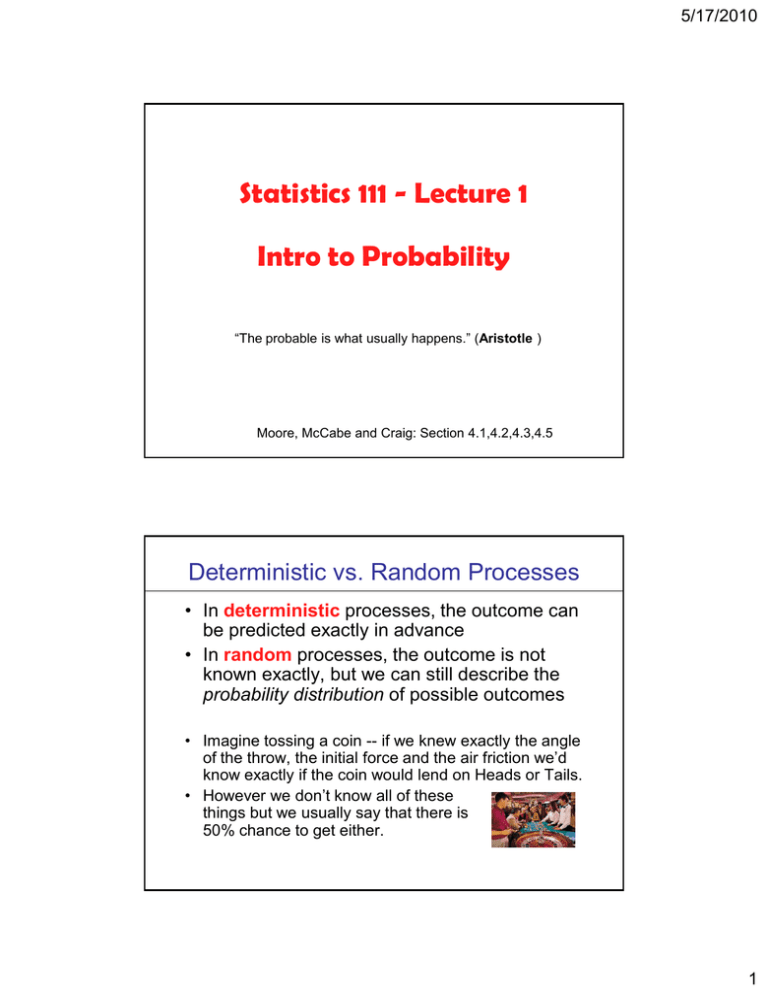
5/17/2010
Statistics 111 - Lecture 1
Intro to Probability
“The probable is what usually happens.” (Aristotle )
Moore, McCabe and Craig: Section 4.1,4.2,4.3,4.5
Deterministic vs. Random Processes
• In deterministic processes, the outcome can
be predicted exactly in advance
• In random processes, the outcome is not
known exactly, but we can still describe the
probability distribution of possible outcomes
• Imagine tossing a coin -- if we knew exactly the angle
of the throw, the initial force and the air friction we’d
know exactly if the coin would lend on Heads or Tails.
• However we don’t know all of these
things but we usually say that there is
50% chance to get either.
1
5/17/2010
Definition: Event
•
An event is an outcome or a set of outcomes of
a random process
Example: Tossing a coin three times
Event A = getting exactly two heads = {HTH, HHT, THH}
Example: Picking real number X between 1 and 20
Event A = chosen number is at most 8.23 = {X ≤ 8.23}
Example: Tossing a fair dice
Event A = result is an even number = {2, 4, 6}
•
•
Notation: P(A) = Probability of event A
Probability Rule 1:
0 ≤ P(A) ≤ 1 for any event A
Sample Space
• The sample space S of a random process is
the set of all possible outcomes
Example: one coin toss
S = {H,T}
Example: three coin tosses
S = {HHH, HTH, HHT, TTT, HTT, THT, TTH, THH}
Example: roll a six-sided dice
S = {1, 2, 3, 4, 5, 6}
• Probability Rule 2: The probability of the
whole sample space is 1
P(S) = 1
2
5/17/2010
Combinations of Events
• The complement Ac of an event A is the event that A
does not occur
• Probability Rule 3:
P(Ac) = 1 - P(A)
• The union of two events A and B is the event that
either A or B or both occurs
• The intersection of two events A and B is the event
that both A and B occur
Event A
Complement of A
Union of A and B
Intersection of A and B
Disjoint Events
• Two events are called disjoint if they have no
outcomes in common and can never happen
together
• Example: coin is tossed twice
• S = {HH,TH,HT,TT}
• Events A={HH} and B={TT} are disjoint
• Events A={HH,HT} and B = {HH} are not disjoint
• Probability Rule 4: If A and B are disjoint
events then
P(A or B) = P(A) + P(B)
3
5/17/2010
Independent events
• Events A and B are independent if the probability that
A occurs is not affected or changed by the occurrence
of the B.
• Example: tossing two coins
Event A = first coin is a head
Event B = second coin is a head
Independent
• Probability Rule 5: If A and B are independent
P(A and B) = P(A) x P(B)
Equally Likely Outcomes Rule
• If all possible outcomes from a random process
have the same probability, then
𝑃(𝐴) =
# of outcomes in A
# of outcomes in S
• Example: One Dice Tossed
𝑃 𝑒𝑣𝑒𝑛 𝑛𝑢𝑚𝑏𝑒𝑟 =
"2" + "4" + "6"
1
=
"1" + "2" + "3" + "4" + "5" + "6" 2
• Note: equal outcomes rule only works if the
number of outcomes is “countable”
• Eg. of an uncountable process is sampling any fraction between
0 and 1. Impossible to count all possible fractions !
4
5/17/2010
Equally Likely Outcomes Rule
• You toss two dice. What is the probability of the
outcomes summing to 5?
• 1. Find the sample space.
• 2. Define the event of interest (A)
• 3. Count the number of outcomes in A
Combining Probability Rules Together
• Initial screening for HIV in the blood first uses
an enzyme immunoassay test (EIA)
• Even if an individual is HIV-negative, EIA has
probability of 0.006 of giving a positive result
• Suppose 100 people are tested who are all
HIV-negative. What is probability that at
least one will show positive on the test?
• First, use complement rule:
P(at least one positive) = 1 - P(all negative)
5
5/17/2010
Combining Probability Rules Together
• Now, we assume that each individual is
independent and use the multiplication rule for
independent events:
P(all negative) = P(test 1 negative) ×…× P(test 100 negative)
• P(test negative) = 1 - P(test positive) = 0.994
P(all negative) = 0.994 ×…× 0.994 = (0.994)100
• So, we finally we have
P(at least one positive) =1− (0.994)100 = 0.452
Conditional Probabilities
• Eg. imperfect diagnostic test for a disease
Disease +
Disease -
Total
Test +
30
10
40
Test -
10
50
60
Total
40
60
100
• What is probability that a person has the
disease? Answer: 40/100 = 0.4
• What is the probability that a person has the
disease given that they tested positive?
More Complicated !
6
5/17/2010
Definition: Conditional Probability
• Let A and B be two events in sample space
• The conditional probability that event B
occurs given that event A has occurred is:
𝑃 𝐵𝐴 =
𝑃(𝐴 𝑎𝑛𝑑 𝐵)
𝑃(𝐴)
• Eg. probability of disease given test positive
𝑃 𝑑𝑖𝑠𝑒𝑎𝑠𝑒 + 𝑡𝑒𝑠𝑡 + =
𝑃(𝑑𝑖𝑠𝑒𝑎𝑠𝑒 𝑎𝑛𝑑 𝑡𝑒𝑠𝑡+) 30 100
=
= 0.75
𝑃(𝑡𝑒𝑠𝑡+)
40 100
Independent vs. Non-independent Events
• If A and B are independent, then
P(A and B) = P(A) x P(B)
which means that conditional probability is:
𝑃 𝐵𝐴 =
𝑃(𝐴 𝑎𝑛𝑑 𝐵) 𝑃(𝐴) × 𝑃(𝐵)
=
= 𝑃(𝐵)
𝑃(𝐴)
𝑃(𝐴)
• We have a more general multiplication rule
for events that are not independent:
P(A and B) = P(B | A) × P(A)
7
5/17/2010
Conditional Probabilities
• The (famous) Three Door Problem:
• Let’s say you picked door # 1:
The host can
open either
door 2/3
The host must
open door
number 3
The host must
open door
number 2
If you’ll switch
you’ll loose
If you’ll switch
you’ll win
If you’ll switch
you’ll win
The host gave you extra information by opening the door
Break
June 3, 2008
Stat 111 - Lecture 6 - Probability
16
8
